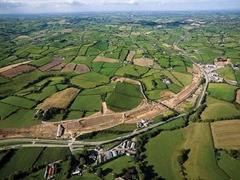When is a plan not a plan?
 Detailed maps to illustrate the impact of applications on residents must be a standard part of the planning process, DIT Head of School of Spatial Planning Henk van der Kamp told eolas’ planning seminar.
Detailed maps to illustrate the impact of applications on residents must be a standard part of the planning process, DIT Head of School of Spatial Planning Henk van der Kamp told eolas’ planning seminar.
According to Henk van der Kamp, from the School of Spatial Planning at Dublin Institute of Technology, the answer to the aforementioned question can be found at the very heart of the planning procedures followed in Ireland.
“According to the Planning and Development Act of 2000, both specific development plans and local area plans must contain both a written statement and a plan or plans,” he told delegates.
“But in cases of conflict, written statements take precedence. Significantly, the word ‘plan’ is not defined in the Act. And this, in my opinion, reflects an important weakness in the current Irish planning system.
Van der Kamp explained: “Planners the world over equate the term plan with a map-based system. As a consequence, development and local area plans must become more maps-focused. Or put another way, maps must be given priority over written statements in planning documents.”
Henk van der Kamp made these points while addressing the bigger issue of what constitutes effective planning policy. In this context, he identified four key concepts:
• confidence;
• consistency;
• clarity; and
• certainty.
He defined confidence in terms of a transparent process of policy adoption, with consistency the means by which all applications fit into a policy at that higher level.
“Clarity ensures that there will be a minimum chance of different interpretations while certainty ensures there is sufficient detail to prepare development proposals,” he further explained. “We also need to monitor the quality of planning decisions by research.”
Plan-led ethos
 The DIT academic stressed repeatedly the advantages of developing a planning ethos which was plan-led rather than project-led.
The DIT academic stressed repeatedly the advantages of developing a planning ethos which was plan-led rather than project-led.
“Local residents, for example, should be able to see exactly how a new road scheme or other infrastructural development will affect them courtesy of a map or plan which is drawn up as part of the development process,” he stressed.
“In my own case, I could only find out the exact location of a slip road onto a motorway, which runs close to my own home, once the project was almost completed. This isn’t good enough.”
He added: “What’s more, part of the delay is caused by the sequential nature of the planning process.” The planning authority component is “not always significant” in terms of the overall length of the planning process. The impact of the Strategic Infrastructure Act on reducing delays may therefore not be as significant as expected.
Detailed maps would allow everyone involved to have “the opportunity to predict more accurately the total impact of a planning application.”
He continued: “I would like to propose that each plan has a single associated map, which can determine what can be done on the land that has been designated for development; the accompanying written statement will explain why.”
Explicit reference to planning policies as well as interpretation of these policies should be included in the assessment of a planning application, he suggested. Policies can be found in documents for different levels of the planning hierarchy and, in his view, the code of conduct should address the question of which level in the hierarchy of plans is most relevant.
He added: “It is suggested that the policy that is most relevant should be found in the lowest plan level in the planning hierarchy and ideally should be represented in a single map. Individual references to parts of the written statement can be confusing, and ultimately can lead to different interpretations on the outcome of the planning recommendation.
“While it is appropriate for a planner to refer to higher level policies, the implications of these policies for the local level should have been incorporated in the local plan and therefore be already indirectly considered when referring to the map.”
Research
Henk van der Kamp then went on to discuss the quality of the planning decision-making process that currently exists in Ireland.
“It’s important that we monitor the quality of the decisions taken by research,” he stressed. “This work will help identify if the broad thrust of the planning decisions taken [is] balanced and in line with current policy.
“This, of course, is not new thinking,” he continued. Work of this nature was carried out thirty years ago by An Foras Forbartha. Back in 1983, an original sample survey of 1 per cent of all planning applications was analysed. This survey was repeated twice, but then discontinued.
“I am strongly of the view, however, that research on the quality of the planning decisions taken should, once again, be undertaken. This will do two things. In the first instance, the work will serve to ensure a consistent quality regarding the planning decisions that are taken. Secondly, it will improve the efficiency and cost-effectiveness of the entire Irish planning process.”
He concluded: “Effective planning requires confidence, consistency, clarity and certainty. Moreover, decisions on planning applications must reflect government policy. This process will be forwarded immensely if detailed maps are used in determining policy.”





